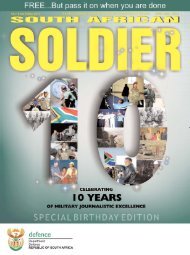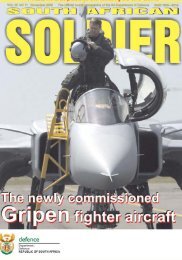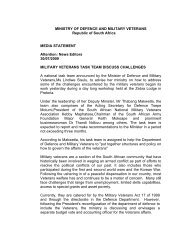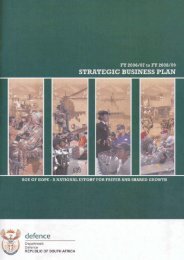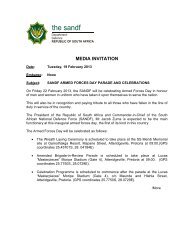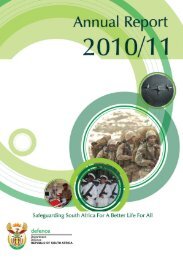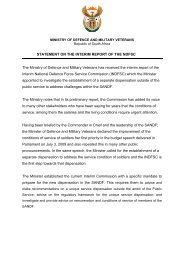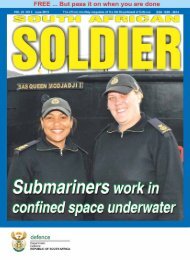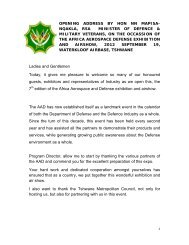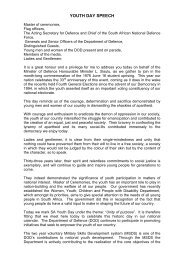Chapter 2 - P rogramme 1 - Department of Defence
Chapter 2 - P rogramme 1 - Department of Defence
Chapter 2 - P rogramme 1 - Department of Defence
You also want an ePaper? Increase the reach of your titles
YUMPU automatically turns print PDFs into web optimized ePapers that Google loves.
| <strong>Department</strong> <strong>of</strong> <strong>Defence</strong> |<br />
APPENDIX A<br />
Status <strong>of</strong> the SANDF Reserves<br />
Project PHOENIX, aimed at ensuring the<br />
transformation and revitalisation <strong>of</strong> the Reserves,<br />
is bearing fruit. This is evidenced by higher<br />
recruitment figures, enhanced leader group training<br />
and increased deployments, complemented by<br />
improved representivity.<br />
Set out below is an overview <strong>of</strong> the progress made<br />
in implementing Project PHOENIX with the aim<br />
<strong>of</strong> preparing the Reserves to fulfil their role as part<br />
<strong>of</strong> the “Core Growth-One Force” concept <strong>of</strong> the<br />
SANDF, as is required by the Reserve Force Strategy.<br />
The challenges for the future are also addressed.<br />
Policy Issues<br />
Implementation <strong>of</strong> the Reserve Force Strategy,<br />
approved in 2004, received a boost in 2007 at the<br />
Reserve Force Symposium when the strategy was<br />
publicly evaluated and endorsed. The Minister <strong>of</strong><br />
<strong>Defence</strong>, the Secretary for <strong>Defence</strong> and the Chief<br />
<strong>of</strong> the SANDF have made the revitalisation <strong>of</strong><br />
the Reserves a priority. Parliamentary interest and<br />
support also continues at a high level.<br />
The role <strong>of</strong> the Reserves has been confirmed in the<br />
<strong>Defence</strong> Update as:<br />
•<br />
•<br />
•<br />
•<br />
providing the majority <strong>of</strong> the conventional<br />
landward defence capability;<br />
providing support to the people;<br />
supplementing peace support operations; and<br />
maintaining a pool <strong>of</strong> specialist skills.<br />
This clarity <strong>of</strong> role and purpose has led to increased<br />
impetus in developing the Reserves and has assisted<br />
in preparing the draft force design and structure.<br />
In addition, the <strong>Defence</strong> Reserves Office has, with<br />
the support <strong>of</strong> the Reserve Force Council, prepared<br />
the following proposals which will, if approved<br />
and implemented, have a material impact on the<br />
development and employment <strong>of</strong> Reserves:<br />
•<br />
•<br />
Draft possible legislation which will facilitate the<br />
call-up <strong>of</strong> Reserves in times other than war;<br />
General Regulations to the <strong>Defence</strong> Act, 2002<br />
(Act No. 42 <strong>of</strong> 20 in so far as they affect<br />
Reserves; and<br />
•<br />
Revised contracts for Reserve service, which are<br />
currently being implemented.<br />
Support is also being given to the Chief <strong>of</strong> Human<br />
Resources in updating human resource policies for<br />
the Reserves.<br />
Recruitment<br />
Service in the Reserves continues to be popular, with<br />
the total number <strong>of</strong> men and women volunteering<br />
now approaching 18 000 out <strong>of</strong> a force design <strong>of</strong><br />
70 052 per the latest draft <strong>of</strong> the <strong>Defence</strong> Update<br />
2025. Of these, more than 70% are from previously<br />
disadvantaged backgrounds, with a concurrent<br />
improvement in gender representivity.<br />
The current strength <strong>of</strong> the Reserves, as rounded<br />
<strong>of</strong>f, is:<br />
SA Army 12 250<br />
SA Air Force 1 050<br />
SA Navy 1 250<br />
SAMHS 1 300<br />
Divisions 1 900<br />
Total 17 750<br />
To date, 3 500 selected former members <strong>of</strong> the<br />
Army Territorial Reserve (Commandos) have been<br />
transferred to the Army Conventional Reserve and<br />
have received retraining.<br />
At the end <strong>of</strong> 2007, the first significant transfer <strong>of</strong><br />
1 800 Military Skills Development System (MSDS)<br />
members to the Reserves occurred. This, together<br />
with the recruitment <strong>of</strong> former Regulars (both from<br />
the former statutory and non-statutory forces), will<br />
have a positive impact on the employment <strong>of</strong> the<br />
Reserves. Progress has also been made in identifying<br />
civilian employment opportunities for MSDS<br />
members joining the Reserves.<br />
Employment<br />
The deployment <strong>of</strong> Reserves in peace support<br />
operations in Burundi and the DRC continues to<br />
be successful and will be expanded to Sudan. The<br />
deployment <strong>of</strong> infantry and CMIS sub-units has<br />
201 Annual Report FY 2007 - 2008<br />
| Appendix A - Status <strong>of</strong> the SANDF Reserves |



